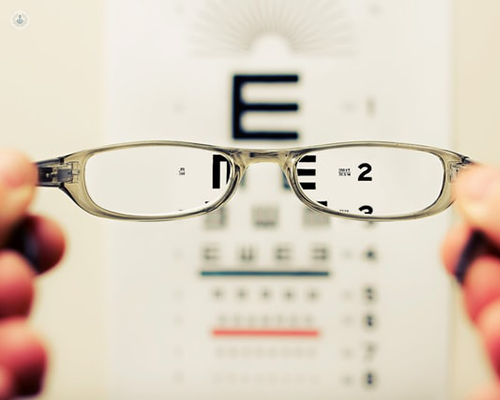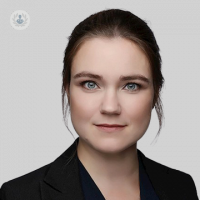Myopia: An in-depth guide to short-sightedness
Written by:Near-sightedness, or myopia, is an increasingly common eye condition which can usually be corrected with glasses or contact lenses. The condition can, however, make patients more susceptible to developing more serious, sight-threatening complications, such as glaucoma and retinal detachment. In this informative article, leading consultant vitreoretinal surgeon Ms Evgenia Anikina explains the known causes of myopia and what can be done to slow the progression of the condition. She also offers expert insight on the available treatment options, including guidance on how often short-sighted patients should visit the optician.

What exactly is myopia?
Myopia is a common condition and its prevalence in the world is increasing. There are a reported eighty million myopic children worldwide, a number that is growing.
Myopia is another name for short-sightedness or near-sightedness, an eye condition where people have trouble seeing clearly in the distance without glasses. This happens because the light rays that enter the eye end up being focused into an image too soon, before they reach the light sensitive membrane (the retina) at the back of the eye. In effect, the focusing power of the eye is too strong for it’s given size.
There are two types of myopia. Simple or common myopia is the condition we generally think of which usually develops in late childhood and adolescence and leads to mild to moderate visual impairment. This is correctable with glasses or contact lenses but can be associated with the development of some other eye conditions, such as retinal detachment and glaucoma. The likelihood of these complications increases the more severe the case of myopia.
The second type of myopia is so-called pathological myopia. In this case, the refractive error usually presents very early in childhood and the degree of myopia does not stabilise as it usually does in the common case, but continues progressing. Eyes often reach very high levels of myopia and there is a greatly increased risk of other eye problems developing. These cases are rare and are more commonly found to have a genetic basis.
What are the main causes of the condition?
There are many myths surrounding the development of myopia. Good scientific evidence has helped to confirm some of these suspicions and refute others. At the present time, we know that the following factors play a role in causing myopia and in accelerating its progression:
- Close work – holding books and devices too close to your eyes when using them
- Increased time indoors and reduced outdoor activity
- Genetic factors
How can the progression of short sightedness be slowed down?
There is no intervention currently available which can reverse myopia or stop its progression entirely. Some strategies which can slow down the rate of progression and/or reduce the final refractive error include:
- Lifestyle measures, such as limiting screen time, in particular close work, i.e. use of smartphones and tablets
- Spending more time outdoors (this has been shown to be an independent factor that helps to slow down myopia progression)
Specialist contact lenses, such as Ortho-K and MiSight also show some evidence of slowing down myopia’s progression rate. However, there are some safety concerns and no large scale studies are available to make a full evaluation.
Additionally, a lot of recent attention has focused on ultra-low concentration atropine drops, which cause the pupil to dilate. However in ultra-low concentration they do not produce this dilating effect, but rather appear to slow down the progression of myopia when used regularly in early myopia in children. Several large studies are ongoing with some promising results. Currently, these drops are not NICE-approved or licensed for this use in the UK, however a license is expected in the near future.
What are the different treatment options for patients suffering from myopia?
It is important to update your glasses or contact lens prescription regularly. This may be necessary every sixth months in childhood or at first diagnosis. If the prescription remains stable however, then annual or bi-annual checks with the optician are advised.
Wearing the correct prescription does not cause your myopia to progress faster and can help to avoid strain headaches. Similarly, over-correction (wearing a prescription that is too strong) should be avoided.
Laser eye surgery can be considered in adults as their eyes have stopped growing and so the procedure would produce stable results. This is not suitable for everybody and a specialist consultation is advised to determine if it is right for you. It is important to note that laser surgery only changes the focusing power of the eye and allows glasses and contact lenses-free vision. It does not change the myopic nature of an eye, which remains susceptible to all the risks of myopia such as retinal detachment and glaucoma.
Some rare treatments involve surgical approaches to change the shape of the back of the eye. These are not widely practiced and carry significant risks, so they are only considered in extreme cases.
Most of the treatment options for myopia focus on addressing the other problems that come from it. The retina is thinner and more vulnerable in myopic individuals, which makes retinal breaks and retinal detachment more likely. A retinal detachment will generally require surgery to fix. Other conditions, such as glaucoma are also more likely to develop and regular monitoring by an optician can help to identify any early signs.
It is important to note that many lifestyle factors which were previously thought to affect myopic eyes have since not shown any association with myopic progression or retinal detachment. For instance, straining, bending over and coughing, as well as childbirth, have no effect on retinal stability and will not increase retinal detachment risk. One consistent factor that does increase this risk is eye injury, in particular blunt trauma, such as that sustained in boxing, as well as (thankfully rare) penetrating eye injuries. Eye protection should be considered in contact and racket sports in individuals with a significant degree of myopia, generally minus six dioptres or more.
If you are concerned about your eye health, don't hesitate to visit Ms Anikina's Top Doctor's profile to book a consultation.


